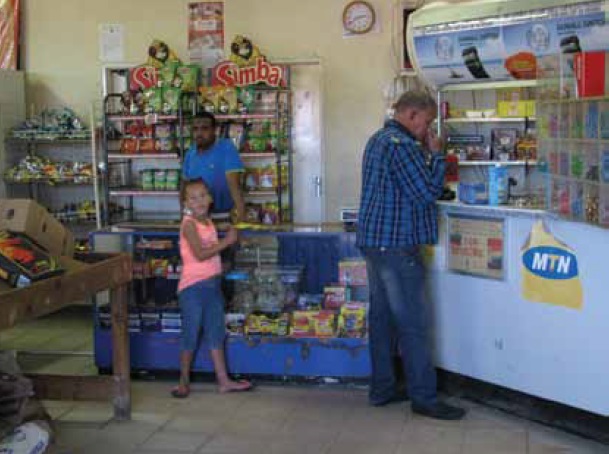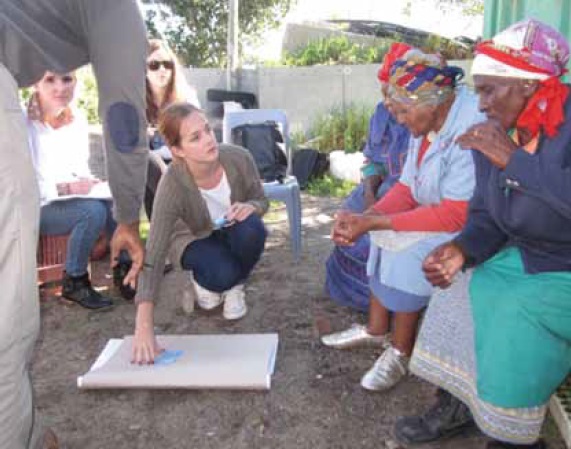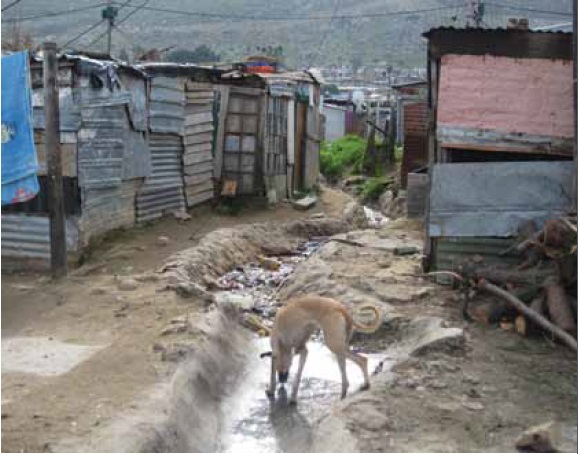Climate change in South Africa – how are we tackling this?

Adapated form an article in Quest Magazine with contributions from Associate Professor Gina Ziervogel.

South Africa faces major changes to its climate. Our average annual temperatures have increased by at least 1.5 times more than the observed global average of 0.65°C in the past 50 years. Added to this, extreme rainfall events have increased in frequency. And, according to Gina Ziervogel and her colleagues, these changes are likely to continue. Quoting the 2013 South African Long Term Adaptation Scenarios and the Fifth Assessment Report of the Intergovernmental Panel on Climate Change (IPCC AR5) for Representative Concentration Pathway (RCP) 8.5 suggest that our temperatures will rise by 3 – 6°C by 2081 – 2100 compared to 1986 – 2005. Climate change poses a significant threat to South Africa’s water resources, food security, health, infrastructure and ecosystem services and biodiversity. In a country where many people are poor and where levels of inequality are high, these effects of climate change are critical challenges to development.

In urban areas such as Picketberg, many households need to buy most of their groceries. High prices of food due to climate shocks can have a significant impact on household income and expenditure. Image: Gina Ziervogel
Climate change as a developmental problem
Given the major effects that climate change will have on our environment and the way that these changes will affect people, climate change research in South Africa is now
no longer seen purely as an environmental problem, but also a developmental problem. To understand why climate change is a developmental problem think about the impacts from increasing temperatures, increased flooding, changes in rainy seasons and changes in winds on many aspects of broader socioeconomic development, such as water availability, food security, housing and infrastructure. South Africa’s per capita emissions are high relative to other countries in Africa, and even globally. So climate change mitigation has been in discussion for some time and academics and government policy makers have worked closely together. Policies that have been developed include the Renewable Energy Independent Power Producer Procurement Programme and the start of carbon taxes. Several government departments – national, provincial and local – are now developing climate change strategies or plans.
The status of climate science in South Africa
South Africa has many excellent universities and science councils, and as a result has a highly advanced research, observation and climate modelling programme. Studies have focused mainly on how the mechanisms that control our climate both yearly and more long-term are affected by climate change, including the way that the oceans around the continent affect our rainfall. Scientists in South Africa have a very good understanding of the way that our natural ecosystems function and the South African Weather Service and other agencies have a wealth of data on our weather systems. All this allows our scientists to carry out research into climate change, natural variability and also to develop models of future climate directions.

University of Cape Town Environmental and Geographical Science Honours students learning about how water is extracted and treated from the Berg River for Picketberg, Western Cape. Image: Gina Ziervogel
Vulnerable areas
Research in South Africa has focused on some areas more than others. The areas where there is significant research include five main groupings: biodiversity, agriculture, water, cities and health.
Biodiversity
The latest findings suggest that the biome that is most threatened by increased temperatures and rising carbon dioxide levels is the grassland biome, which could be taken over by woody plants. The other four biomes that are particularly vulnerable to climate change are the Nama Karoo biome, the Indian Ocean coastal belt, the Fynbos biome and the Forest biome.
Agriculture
The impact of climate change in agriculture is likely to be on staple crops such as maize and on the forestry industry. One of the main concerns is a projected increase in the need for irrigation since most parts of the country are likely to become drier. Models also suggest that key cereal crops such as maize in the winter rainfall region and wheat in the summer rainfall region will be negatively affected by climate change. Another concern is that certain pest and pathogen species will benefit from the changing climate and become more of a problem for agriculture.

Third year UCT Environmental and Geographical Science students doing fieldwork in Philippi, an urban agricultural area in Cape Town. The students carried out a vulnerability assessment to understand the exposure of these smallholder farmers to water supply. Image: Gina Ziervogel
Water
Modelling what will happen to water supplies is difficult as the system is so dynamic and changeable. Essentially, all models predict more flooding in some areas and more droughts in others. If the climate becomes drier then land use that seriously affects water catchments, such as encroaching on wetland areas, changing the course of rivers and so on, will place greater demands on water resources if the climate becomes drier. What is still to be explored is the interaction between changes in water quality and quantity and the impacts that such changes will have on various types of water use, e.g. irrigation, domestic consumption or aquatic ecosystems.
Cities and the built environment
There is not as much research into the impact of climate change on cities as there might be, given that most people live in urban areas. The exceptions are eThekwini municipality and The City of Cape Town. Projections of the impact of climate change on cities as a whole are lacking but there is some research on certain aspects of climate impacts at the local level, such as the impact of sea level rise on coastal communities, water resources under climate change and the impacts and response to flooding in cities. The main research has focused on sea level rise and the water sector. The impact of rising sea level in both eThekweni and Cape Town have been evaluated using models. There have been a few studies of possible impacts on water supply and demand in cities as the climate changes, but there is a lot of variation in the data used for the models, so that impacts are uncertain

The informal settlement of Langrug in Franschoek, Western Cape, has significant challenges in ensuring clean water. There have been a range of innovative responses through collaboration between the municipality, provincial government and local communities. Image: Gina Ziervogel
Health
The health impacts of climate variability and change are increasing. Studies in South Africa have focused on health outcomes that are sensitive to climate, such as diarrhoeal diseases, respiratory diseases, cardiovascular health and vector-borne infectious diseases such as malaria. Other factors that influence health are heat stress, heavy rainfall and drought. Data on hospital admissions and deaths have shown that people’s health is affected by these events. Vector-borne diseases such as malaria are predicted to shift in area from west to south to east, driven by climate change impacts, although no overall increase in incidence is predicted. The other main health risks that may be affected by climate change include food insecurity, hunger and malnutrition, natural disasters, air pollution, infectious diseases – specifically HIV/AIDS – noncommunicable diseases, high injury burden, mental health and occupational health. An example of occupational health effects is heat stress on people working in agriculture.
In South Africa and internationally there are many scientists who are focusing on understanding how we can adapt to medium- or long-term changes in the climate. At the moment, however, most adaptation responses still focus on reducing vulnerability to present-day climate problems, such as disaster risk reduction, early warning systems and water demand management. Scientists and the South African Government are currently working on research to explore the design of a system that will evaluate adaptation responses that aim to adapt to current and future climate variability.
Some groups have already taken a practical approach to adaptation and in the agricultural sector, individual farmers and farmers’ associations are interested in climate change findings and many have started adapting to their experience of historical changes. For example, in the Western Cape, apple orchards have been replaced by vineyards which are more tolerant of high temperatures. In the southern Cape, commercial farmers have changed from crops to pasture and have increased their capacity to store water. In the Suid Bokkeveld, in South Africa’s arid western region, the emerging agricultural sector in the area is working on understanding the impacts of climate variability and change on rooibos tea farming.
Within business, Santam (a short term insurance company) has an innovative response to climate change. The company noticed increasing insurance claims particularly in the Eden District Municipality in the Western Cape Province as a result of extreme weather events. These were fires, made worse by periods of drought and fanned by strong winds, flooding and storm surges. Santam decided not to increase insurance premiums. Instead they started a pilot project in collaboration with the CSIR and Worldwide Fund for Nature (WWF) to assess landscape-wide measures to reduce these risks. They identified drivers of climate risks that could be directly or indirectly modified by Santam and its partners. A good example is reducing fire risk through support for the Working for Water programme.
The way forward
Although South Africa is making significant progress in understanding the impacts of climate change and in starting to implement and evaluate adaptation responses, more work is needed. There are two areas in particular that require research in coming years: the knowledge gaps related to inadequate climate impact assessments and understanding and quantifying the socioeconomic costs of climate change and the problems that scientists and people on the ground have collaborating effectively to meet the country’s needs. In conclusion there are three critical research areas that would strengthen adaptation research and practice. These are:
- The development and testing of approaches that support ntegrated and flexible adaptation strategies
- An improved understanding of the social, political, governance and financial barriers or enablers of adaptation in South Africa
- How adaptation can address the reduction of poverty and inequality, which is one of the key priorities of the National Climate Change Response White Paper. q
Reference
Ziervogel G et al. 2014. Climate change impacts and adaptation in South Africa. WIREs Climate Change 2014. doi: 10.1002/wcc.295
Disclaimer: The views expressed here are solely those of the authors in their private capacity and do not in any way represent the views of the ACDI, or any other entity affiliated with the ACDI.